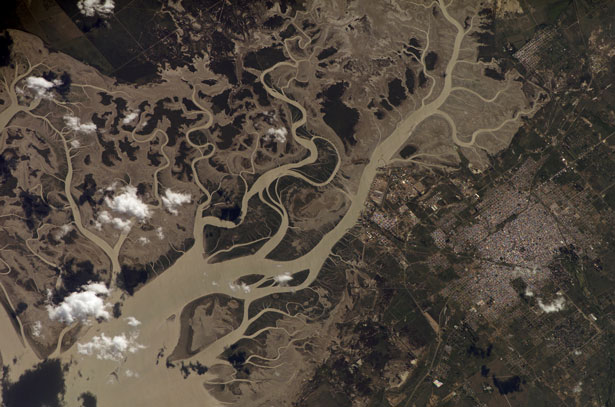-
A Year for Cooperation, Not Conflict, Over Water
February 12, 2013 By Kate Diamond
You might think that conflict over water is inevitable as rising temperatures and changing climates are expected to constrain supplies in the coming decades at the same time that expanding consumption standards and growing populations are expected to boost demand. But you’d be wrong, according to the United Nations – and they’re launching the International Year for Water Cooperation this week to make that point.
Water Collaboration
Collaboration over water has been the rule rather than the exception over the past 70 years, according to a special edition of the UN Educational, Scientific, and Cultural Organization’s (UNESCO) quarterly journal, A World of Science. In their article “The Key to Managing Conflict and Cooperation Over Water,” co-authors Annika Kramer, Aaron Wolf, Alexander Carius, and Geoff Dabelko highlight some impressive points from a study on water cooperation and conflict from 1945 to 2008 to prove conventional wisdom on “water wars” wrong:
- There were more than twice as many cooperative events than conflicts between riparian states.
- International cooperation increased during droughts.
- There is a wide range of ways in which states cooperate (on water quantity, quality, economic development, hydropower, and joint management), while nearly 90 percent of conflict-laden events related to just two issues (quantity and infrastructure).
- Underlying reasons for water-related controversy can be numerous (such as power struggles and competing development interests), but all water disputes can be attributed to one or more of three issues: quantity, quality, and timing.
- Almost no single characteristic was linked to conflict: Arid climates were no more conflict-prone than humid ones; democracies were as susceptible to conflict as autocracies; rich countries as much so as poor ones; densely populated countries as much so as sparsely populated ones; and large countries as much so as small ones.
The sheer number of countries and people sharing river basins makes the stakes for water cooperation all the more impressive. Once again, from Kramer et al.:
- The territory of 148 nations falls within international river basins, and more than 30 countries are located almost entirely within these basins. The Danube is shared by 19 countries, the Nile, by 11.
- International basins that included political boundaries of two or more countries cover around 45 percent of the Earth’s land surface, host about 40 percent of the world’s population, and account for approximately 60 percent of global river flow.
- In 1978, the United Nations listed 214 international basins; today there are 276.
Will the Future Be Like the Past?
All that said, the authors acknowledge that the changing dynamics of global water mean that simply because cooperation has been the rule in the past does not mean it should be presumed for the future.
Aaron Wolf on transboundary water basins and institutional resilience Climate change is hitting hardest in regions of the world already struggling with water stress and insecurity. Populations are growing rapidly in already-crowded river basins. Links between water, food security, and energy are rising in prominence at the same time that climate change, population growth, and rising consumption are putting unprecedented pressure on them, and yet the institutions and systems set up to manage water remain segmented in bureaucratic silos that hamper their effectiveness.
Add the changing nature of conflict – which is being “driven increasingly by internal or local pressures or, more subtly, by poverty and instability,” and the water disputes of tomorrow, “may look very different from today’s,” the authors write.
Getting Outside the Silo
Cross-sector collaboration and strong institutions will be essential to successfully managing water resources amid these new challenges, according to Gretchen Kalonji, UNESCO’s assistant director-general for natural sciences. In an introduction to the special issue, she describes four key aspects of water cooperation, all of which will be focal points for the International Year of Water Cooperation.
Water cooperation, Kalonji writes…
- Is vital for poverty eradication and social equity;
- Yields economic benefits;
- Helps to preserve water resources and protect the environment; and
- Builds peace.
Understanding the multifaceted nature of livelihoods, global development, security, and water – indeed all kinds of natural resources – is critical. Even though the Millennium Development Goal to expand access has been met, more than 1 in 10 people still live without clean drinking water. The UN warned earlier this year that all of Gaza could be without safe drinking water by the end of the decade.
At the same time, too much water can be just as much a problem as too little, as climate change makes weather more variable and urbanization, particularly along the world’s coastlines, puts more people in the path of storm surges, floods, and rising sea levels.
While the challenges surrounding water management are numerous, the International Year for Water Cooperation serves as a useful reminder that the opportunities – and need – for progress are immense.
Photo Credit: “Bahia Blanca, Buenos Aires Province, Argentina (NASA, International Space Station Science, 10/14/06),” courtesy of NASA’s Marshall Space Flight Center. Video: Sean Peoples/Wilson Center.
Sources: The Guardian, UNESCO.
 A Publication of the Stimson Center.
A Publication of the Stimson Center.



